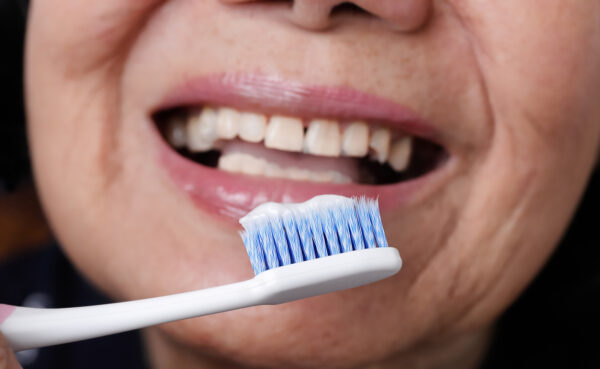Let’s Get Tooth-Friendly

As eyes are the window to the soul, your mouth is a window to your overall health and wellness.
Since the demographic of older adults (usually defined as 65 years of age and older) is growing, older adults will continue to be a large part of dental practices, not only now but increasingly so in the years to come. Many older adults live with multiple chronic conditions that can make it more challenging to maintain proper oral health.
For instance, if you take several prescriptions and/or over-the counter medications due to medical conditions, your salivary flow will be lowered, sometimes to the point of dry mouth (xerostomia). The same is also true if you have had chemotherapy and/or radiation therapy (especially to region of your mouth). Older people who have exposed root surfaces (which happens as we age) and visible plaque on teeth and gums, who are at higher risk for dental caries (tooth decay or dental cavities) because of the bacterial growth and the lowered salivary flow, have an acidic oral environment. Acid-producing bacteria—including Streptococcus mutans—love these acidic conditions.
What is the concern about dry mouth?
To remain healthy, our oral tissues need to be constantly bathed with saliva. The constant flow of saliva gets rid of food debris and bacteria as we swallow. Saliva also helps to buffer the acidity from bacteria and from the food that we eat. If we have a lowered saliva flow, this leads to build-up of plaque and bacteria that will cause dental caries if we are unable to brush.
What is pH and why is it important to oral health?
The term pH stands for potential hydrogen and is a measure of how acid or basic a substance is. The range goes from 0‒14 (in which 7 is neutral). If a pH is less than 7, it means the substance is acidic. A pH of greater than 7 means a substance is basic.
If a pH is too low or too high, it can damage your tissues, and this includes your oral tissues. Blood pH is kept under tight control with a range between 7.35–7.45. Oral cavity pH, on the other hand, normally fluctuates between 6.8–7.5, with lowered salivary flow and increased bacterial growth causing more acidity. Oral pH, as measured in resting saliva, has been known to be as low as 5.2 at the University of Washington School of Dentistry’s geriatric clinic.
Streptococcus mutans is known to be an expert survivor in acidic conditions below 5.5. Acidic oral fluids damage both tooth enamel and exposed root surfaces, leading to tooth decay and cavities. Tooth enamel and root surfaces that become too thin lead to discomfort or pain when drinking hot, cold, or sugary drinks.
If you have alkaline (or basic) pH in your mouth, this will instead improve enamel strength and re-mineralization of both enamel and root surfaces, especially if your pH levels are 7.5 or higher.
You may wonder how to tell if your saliva pH is out of balance. Bad breath, sensitivity to hot or cold food or beverages and/or tooth cavities are indications.
So, what can you do?
Following are tips that can help make a difference:
- Think about a tooth-friendly diet, focusing on foods with a neutral pH, and limit intake of acidic foods and beverages.
- Physical consistency of foods is important due to their retention. Sticky foods like sticky rice, crackers, sweet foods, and potato chips clear slowly from the teeth and mouth.
- Consider more neutral pH foods or basic foods like arrowroot crackers, asparagus, broiled seafood like sea bass.
- Use a sugar alcohol like Xylitol instead of sugar. Oral bacteria are unable to utilize Xylitol as a food source, so you will hinder the bacterial growth.
- Drink water instead of soda or acidic beverages. Tap water in Seattle has a pH of 8.2 at its water source.
- Do not brush after eating or drinking acidic foods or beverages. Wait at least 30 mins before brushing, so that your saliva can buffer the oral fluid back to neutral.
- Rinse your mouth after eating something acidic, using baking soda in your water (one teaspoon baking soda in a full glass of water).
- Use a high fluoride toothpaste or brush with toothpaste that contains baking soda (or brush with pure baking soda).
- Use a soft toothbrush and do not brush your teeth too hard. Stiff coarse bristles can wear down and damage both teeth and gums, which can lead to gum recession, teeth enamel wearing down, and tooth sensitivity.
- If you wear partial dentures, don’t forget to take them out to clean regularly throughout the day.
Local services and resources
- For dental services in King County, visit https://lahai.org/services/dental.
- For additional tips, see our Oral Health Self-Management Plan.
- Learn more about pH of foods here.
- Read previous AgeWise King County articles about oral health, including A Case for Providing Oral Health Care for All Veterans (December 2022) and Oral Health: Essential During COVID-19 (December 2020).
 Contributor Mary Pat O’Leary, RN, BSN, a senior planner in the Seattle Human Services Department’s Aging and Disability Services division, collaborated with Dr. Susanne Kölare Jeffrey DDS, PhD, Clinical Assistant Professor, Course Director, Geriatric Dentistry at the University of Washington to write this article.
Contributor Mary Pat O’Leary, RN, BSN, a senior planner in the Seattle Human Services Department’s Aging and Disability Services division, collaborated with Dr. Susanne Kölare Jeffrey DDS, PhD, Clinical Assistant Professor, Course Director, Geriatric Dentistry at the University of Washington to write this article.
![AgeWise King County [logo]](https://www.agewisekingcounty.org/wp-content/themes/agewisekingcounty/images/logo.png)